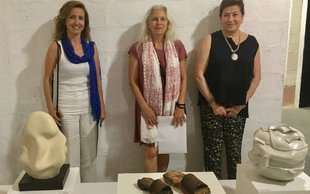
Taking Lebanese Ceramic Art to a Higher Place
Ceramics is getting more and more popular and this competition proved us...
The fields marked with * are mandatory
Standing for all Lebanese men who have emigrated from their home country to seek greater fortunes and peace
He stands tall and all alone, stern look, facing the sea and the sunset, turning his back to Beirut and the hinterland – and surprise, surprise, the EDL (Electricté du Liban) building. Standing for all Lebanese men who have emigrated from their home country to seek greater fortunes and peace in far away countries such as Brazil, Argentina, America, Australia and Mexico, amongst many others, The Lebanese Emigrant statue reminds those circling him leaving on a bus from Charles Helou to Tripoli or driving into Beirut, of the vast amount of Lebanese who make up the supposedly 14 million strong Lebanese Diaspora. But does his presence truly mirror the history of the mahjar (emigration)? And did really only men emigrate?
The statue near the port was set up in 2002 by Mexicans of Lebanese descent. The Board of Directors of the Centro Libanés, established in Mexico City in 1967, commissioned Ramis Barquet, a Mexican artist with Lebanese roots to create a statue in honour of Lebanese emigrants. Known in Spanish as the Lebanese “emigrante”, the statue weighs 1.5 tons, stands 3.5 metres tall and was made of bronze. The Emigrant wears traditional garb, notably a lebadeh, the traditional conical hat, a shirwal (trousers bunched up), wears jasma (leather boots) and a sacco (traditional jacket). Over the years, numerous other replicas of the Emigrante have been set up in other Mexican cities.
According to Dr Guita Hourani, director of the Lebanese Emigration Research Center (LERC) based at Notre Dame University (NDU), the first group of Lebanese emigrants disembarked in the port of Veracruz in Mexico. Hard work, a gastronomy that quickly found new adherents, and the ability to adapt well to new environments and to seize or create opportunities lead to Lebanese emigrants to thrive.
According to Dr Najwa Nasr, women were also part of the earliest Lebanese migration. “Before 1899, they constituted about 27 percent of the available immigration figures. Between 1899 and 1910, women, motivated by the same economic desire as men, as well as by their marriage possibilities (since villages were emptied of single men), raised the percentage to 32. It was pushed upward markedly to 47.5% from 1919 to 1930 by the arrival of wives, brides, and mothers who came to live in more settled…communities.”
“The travel facilities and the will to improve a family’s financial situation have been major factors behind women’s migration,” states Hourani. “Firstly, they worked in trade because of their lack in qualifications, but some women were competent and skilled enough to act in politics and journalism.”
Aqlah Brice Al-Shidiac from Beit Moundhir in Northern Lebanon, for example, left her husband and six children in 1894 and became a successful peddler in America, eventually sending money back to her loved ones and bringing all over to join her, except her husband who feared the ocean too much. Not only did she provide for her family but she was also donating money to local causes.
“Immigrant women in Argentina were also pioneers in forming debating clubs, committees, and women’s associations, and in most cases dedicated themselves to charitable activities,” Hourani pointed out. “Lebanese women were no exception. Shoulder to shoulder with men, they undertook charity work in different provinces, collected funds to assist the needy, produced clothing, and collaborated with religious and educational organisations.”
The cultural legacy carried by Lebanese immigrants (including language, cuisine, and oral family history) was as a whole transmitted by Lebanese mothers since they were the ones with whom children spent the bulk of their time. Lebanese immigrants who married women of other nationalities experienced more difficulties in passing on their culture.
Asked whether a Lebanese woman should keep the Emigrant company, Hourani replied: “ sure why not a woman next to the statue. It is a great idea!”
Get updates on what's happening in Beirut, customise and review the content you want.
Sign up now! It's free!